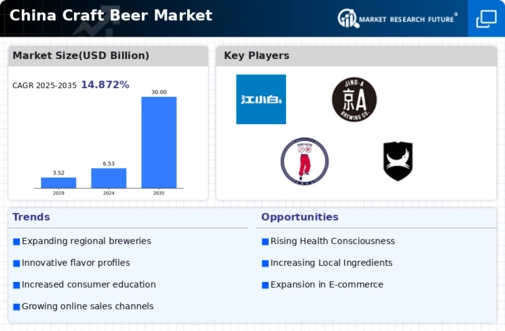Growing Interest in Beer Tourism
Beer tourism is emerging as a significant driver for the craft beer market in China, attracting enthusiasts eager to explore local breweries and their offerings. This trend is supported by the increasing number of beer festivals and brewery tours, which provide consumers with immersive experiences. The craft beer market is capitalizing on this interest, as breweries often report higher sales during such events. Additionally, regions known for their craft beer production are seeing a boost in local tourism, contributing to economic growth. It is estimated that beer tourism could generate upwards of $500 million annually for the craft beer market by 2026, highlighting its potential as a key growth area.
Expansion of Distribution Channels
The craft beer market in China is witnessing an expansion of distribution channels, which is crucial for reaching a broader audience. Traditional retail outlets are increasingly complemented by online platforms, allowing consumers to purchase craft beers conveniently. This shift is supported by the rise of e-commerce, which has seen a growth rate of over 30% in the beverage sector. Additionally, partnerships with restaurants and bars are becoming more common, providing craft breweries with greater visibility and access to consumers. The craft beer market is thus adapting to these changes, enhancing its reach and availability. As distribution networks continue to evolve, it is likely that the market will see increased sales and brand recognition, further solidifying its position in the beverage landscape.
Influence of Social Media Marketing
Social media marketing is playing a pivotal role in shaping the craft beer market in China. Breweries are leveraging platforms like WeChat and Douyin to engage with consumers, share their stories, and promote new products. This strategy appears to resonate well with younger demographics, who are more inclined to explore craft beer options based on social media recommendations. The craft beer market is thus benefiting from this digital engagement, as it fosters community and brand loyalty. Reports indicate that breweries utilizing social media effectively can see a sales increase of up to 25%. As this trend continues, it is anticipated that social media will remain a vital tool for marketing and consumer interaction in the craft beer sector.
Rising Consumer Interest in Craft Beers
The craft beer market in China is experiencing a notable surge in consumer interest, driven by a growing appreciation for unique flavors and artisanal production methods. As consumers become more discerning, they seek out craft beers that offer distinct taste profiles, often influenced by local ingredients. This trend is reflected in the increasing number of craft breweries, which has grown by approximately 20% annually over the past few years. The craft beer market is thus benefiting from a shift in consumer preferences towards premium products, with many willing to pay a premium for quality. This evolving landscape suggests that the craft beer market will continue to expand as more consumers explore diverse offerings, potentially leading to a market value exceeding $10 billion by 2027.
Health Consciousness and Low-Alcohol Options
The craft beer market in China is adapting to the rising health consciousness among consumers, leading to an increased demand for low-alcohol and healthier beer options. As more individuals prioritize wellness, breweries are responding by developing products that align with these preferences, such as low-calorie and gluten-free beers. This shift is indicative of a broader trend within the craft beer market, where innovation is driven by consumer health trends. Reports suggest that low-alcohol craft beers could account for up to 15% of total craft beer sales by 2028. This evolution not only caters to health-conscious consumers but also opens new market segments, potentially enhancing overall market growth.
















Leave a Comment